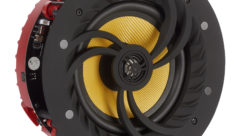Opportunity in Wireless Speaker Market
Nov 19, 2013 12:41 PM
There has been some buzz in the industry regarding wireless speakers. Some integrators see them as a DIY threat. While the option to simply connect devices over a wireless network clearly requires less physical labor than drilling holes and pulling cable, it does not by any means make it easier to create a reliable system. In regards to performance and reliability, wireless technologies have come a long way in recent years, however, with more and more wireless devices being crammed into homes every day, the available RF frequency spectrum has been filled to capacity and interference has become a major issue that these products must contend with in real world applications. This means that integrators have an opportunity to make money by conducting RF site surveys in order to ensure that the system is configured to perform at its absolute best and these wireless devices all operate reliably day in and day out.
In addition to being the expert on wireless technologies, integrators also have valuable knowledge and experience in the realm of audio and acoustics that cannot be ignored when designing a media room, home theater, or distributed audio system. Even though connecting the speakers may be easier, they must still be placed appropriately in the room to create the correct listening environment. Finally, professional calibration is an absolute necessity in order to ensure proper focus, envelopment, clarity and seat to seat consistency. These are all skills that tech pros should be making money on and very few DIY consumers can compete with (for more information see CEA/CEDIA-CEB22 Home Theater Recommended Practices: Audio Design).
As with any technology there are best practices that should be followed. Meeting the needs of users is paramount. When specifying wireless speakers, the first step for an installer is to find out what equipment, mobile devices, and local media storage the customer currently has in order to design a system that is as compatible as possible with the existing media, devices, and systems.
Bluetooth offers the greatest interoperability with existing mobile devices, but quality and range are severely limited. Proprietary technologies offer excellent results but can limit choice in product. The key is to design a system that balances convenience and compatibility with sound quality.
CEDIA’s recent white paper Wireless Audio Solutions: Technologies and Best Practices discusses additional tips, available technology, and recommended reading. This white paper can be found in the CEDIA Marketplace and is available free to members or at a rate of $9.99 to non-members.
What’s the bottom line with wireless speakers? Clients want them! High performance wireless speakers have opened the door to an entirely new market of consumers that want the technology, reliability, and performance of a high quality surround sound system but aren’t willing to allow the intrusion of traditional retrofit methodologies. Wireless systems also allow scalability, which means clients that have gotten a taste of a quality audio system will continue coming back to upgrade (from 5.1 to 7.1 or 3 zones to 4 or 5) for years to come.
To learn more about wireless speaker systems check out our archived webinars on the topic at cedia.net/elearning.










